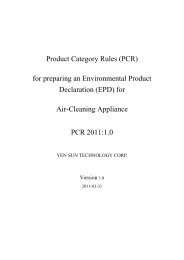Download(PDF) - PCR Library
Download(PDF) - PCR Library
Download(PDF) - PCR Library
You also want an ePaper? Increase the reach of your titles
YUMPU automatically turns print PDFs into web optimized ePapers that Google loves.
PRODUCT CATEGORY RULES<br />
DATE 2012-08-23<br />
UN CPC 013<br />
FRUITS AND NUTS<br />
Waste management shall be included in the system boundaries. Where waste is used as animal feed this shall be<br />
quantified and transport requirements included.<br />
Waste water treatment shall be included in the system boundaries.<br />
The manufacturing of production equipment, machinery and infrastructure (e.g. sheds, buildings etc) and other capital<br />
goods shall not be included.<br />
Business travel of personnel may be included. Travel to and from work by personnel should not be included.<br />
Research and development activities may be included if relevant. This should be regulated on more detailed CPC<br />
levels.<br />
Recycling of secondary packaging may be included in a quantified way. However, in that case it shall be reported<br />
separately and only the transportation to the recycling unit shall be included, while recycling will not be included in the<br />
total sum of the environmental impact of the core module.<br />
7.1.2 GEOGRAPHICAL BOUNDARIES<br />
The data for the core module shall be representative for the actual production processes and representative for the<br />
site/region where the respective process is taking place. Where data derive from many orchards, farmers or perhaps<br />
regions then inflows and emissions shall be representative of the average. Specific data should be collected from the<br />
site/region under study and retain the data quality rules described in Section 7.4.<br />
7.1.3 TIME BOUNDARIES<br />
Data on the product should reflect the entire lifetime of the product from establishment of the crop through to its end of<br />
life. Specific data shall be collected to represent the year(s) for which the production cycle was studied and the<br />
year/time frame for which the EPD is valid. EPD validity may be extended to 3 years provided that underlying data<br />
remains representative of the product as first declared, i.e. varying less than 10% in the second and third year. Specific<br />
data to be used for the study period will comply with data quality rules described in Section 7.4.<br />
7.1.4 BOUNDARIES TO NATURE<br />
Boundaries to nature are defined as flows of material water and energy resources from nature into the production<br />
system. Emissions to air, water and soil cross the system boundary when they are emitted from or leaving the product<br />
system.<br />
7.1.5 BOUNDARIES TO OTHER PRODUCTS LIFE CYCLES<br />
If there is an inflow of recycled material to the production system in the production phase, the recycling process and<br />
the transportation from the recycling process to where the material is used shall be included. If there is an outflow of<br />
material to recycling, the transportation of the material to the recycling process shall be included. The material going to<br />
recycling is then an outflow from the production system.<br />
7.2 CUT OFF RULES<br />
Life Cycle Inventory data for a minimum of 99 % of total inflows to the core module shall be included. The maximum of<br />
all exclusions shall not exceed 5% of the total inflows, and the final emissions should be pro-rated to 100% if omissions<br />
have occurred. Inflows not included in the LCA shall be documented in the EPD.<br />
7.3 ALLOCATION RULES<br />
7.3.1 ALLOCATION BETWEEN DIFFERENT GRADES OF PRODUCT<br />
Where fruits and nuts are destined for human consumption, even though they may be of potentially different grades,<br />
they are considered equivalent in terms of the service they deliver, therefore no allocation is appropriate.<br />
PAGE 9/18















